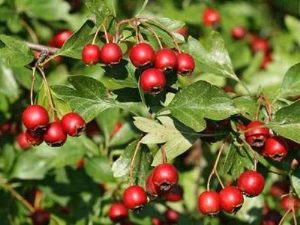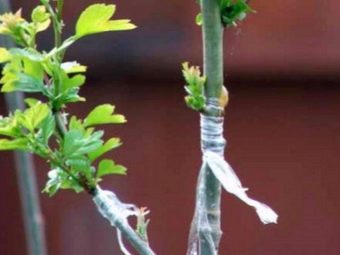Hawthorn: how to grow this beautiful plant in your garden?

Many people think about hawthorn planting on their land. This storehouse of vitamins is a completely unpretentious plant in the middle lane, and even a beginner in gardening can cope with the cultivation of a healthy and beautiful shrub in his garden. Hawthorn is actively used for landscaping in landscape design and as a tapeworm, and as a hedge.
Description and properties
Hawthorn is a shrub or tree with a height of 1 to 4 meters, some varieties in the southern regions grow to 6 meters in height. It belongs to the Rosaceae family, the angiosperms division, the class of dicotyledonous plants. It blooms in central Russia in May-June with white or pink flowers, gathered in dense corymbose inflorescences. In August, fruits ripen in the form of berries of red, pink or dark wine-colored, depending on the variety. Fruits have from 2 to 4 seeds, the flesh is fresh and sweet. The branches are covered with thick spines 2.5–4 centimeters long.
Dense foliage has a beautiful dark green color of the upper side of the leaf and light green - the bottom. The leaves are 3-7-lobed, large-toothed, European-looking, has an entire edge of the leaf. Beautiful flowering, thorny branches, pleasant green color of foliage in summer and red-purple color of leaves with clusters of fruits in autumn, uniform habit of the crown make hawthorn indispensable for hedges. The advantage is the dense foliage at the bottom of the bush, which allows you to create a dense green fence along the entire height.
When a single planting should take into account the falling off of the thorns and their hardness, so you should walk with thick-soled shoes in the foot of a tree to avoid injuries.
The bush fructifies annually, so it is possible to admire the spectacular flowering every spring. Unfortunately, the smell of flowers is not too pleasant, so you should not plant hawthorn next to the porch or seating area. But in the landscape a beautiful rounded crown creates a bright accent, cuts well, it can be given a certain shape. At the same time, haircut reduces fruiting and flowering, and with a strong annual pruning they may be absent altogether. This is due to the fact that the fruit buds are laid in the summer of this year for fruiting in the next season.
Hawthorn can grow in the shade and in the sun, but in the shade flowering and harvest of berries will be lower. Unpretentious plant does not require frequent watering. The soil composition is suitable for any other than acidic soils. For gardening in temperate latitudes, it is better to choose frost-resistant varieties - they do not need to be sheltered for the winter, they develop well in natural conditions. In nature, propagates by root shoots and spread by seeds with bird droppings. Widely distributed in the undergrowth of the Volga region, in the meadows and edges of the Leningrad and Moscow regions, in the Baltic countries.
Hawthorn is very durable, it will delight with its flowering and bring useful fruits not only to you, but also to your grandchildren. The life of this shrub is close to 100 years under favorable conditions. The plant has a strong root system that goes several meters deep, so it easily tolerates drought, feeding on moisture from the deep layers of the soil. In the first 4 years after planting, it gives a very slow increase due to the active growth of the root system, subsequently - up to 50 centimeters a year, and by 10 years the plant is considered an adult and its growth stops.
Hawthorn fruits are harvested in August and consumed both fresh, and in dry or in the form of compotes, jam, kissel, decoction, tincture. Hawthorn berries have a stimulating effect on the brain, are useful in diabetes, improve oxygen metabolism in tissues.
Broths and tinctures are indicated for ischemic disease and heart attacks, they contribute to the treatment of gynecological diseases, infertility. Berry masks have a rejuvenating effect.
Crushed dried fruits are added to bakery products with vitamin deficiency. The bark of plants is treated for diarrhea, it is used as a febrifuge, it can be dyed with tissue red, brown and yellow. Hawthorn flowers are used for medicinal use - they are indicated for thyroid dysfunction, hypertension, help strengthen the immune system and normalize sleep.
Kinds
Hawthorn has more than 200 species, this unpretentious plant has firmly occupied its niche throughout the globe, except for the Far North. The following species and varieties resistant to temperate climate are recommended for breeding in Russia for gardeners.
- Blood Hawthorn - the king of the middle band undergrowth. The most common type of shrub in gardens is up to 3 meters high, with a shallow-lobed large, up to 10 cm, wedge-shaped leaf. Round bright red berries with a diameter of 1 cm are used for medicinal purposes and are very decorative in the fall. Frost resistant Spines - rare, 2 cm long. Flowering spectacular in late May - early June. The gardens are planted in the form of hedges or tapeworm.
- Hawthorn odnopestichny or Crimean - cultivated in the southern regions of Russia in the form of a tree with a height of 3-5 m with rare thin spines and oval edible fruits with one bone of a reddish-brown color. It can grow in temperate climates, but sometimes freezes over in winter. The tree does not die - dead branches are cut, but due to this decorativeness is lost and fruiting is reduced. It is used in the landscape in green hedges, gratefully responds to the haircut.
- Hawthorn is spiny. The distribution region is from the latitude of Moscow and to the south. The shoots are densely covered with spines, it has a very dense crown 3-5 meters high, the leaves are medium 3-5-lobed. Berries are brown-red, 1 cm in diameter. Very well gives in to formation in dense dense hedges and green figures.
- Peristonadresis Hawthorn remarkable very beautiful shape of a long shiny sheet with deep feathery incisions. The berries are large (up to 1.5 cm in diameter) with white tubercles, very decorative. Gives numerous root shoots. Frost resistance is high, due to which the species is distributed in the Far East. Due to its external data and high adaptability to the growing conditions, the tree confidently takes up positions in the gardens of the temperate climate zone.
- Fan hawthorn - shrub form with dark green egg-shaped leaves. The wood is covered with curved long (up to 10 cm) spines. Fruits - oval yellow-orange medium size. Drought-resistant, frost-resistant, resistant to harmful impurities in the air, ideal for creating impregnable clipped hedges up to two meters.
- Large Arnold Hawthorn - the most interesting view for landscaping a garden. It has very large fruits (up to 2 cm in diameter), berries are sweet. These are tall plants, in the southern regions they reach 7 meters in height, in temperate latitudes - 3-4 meters, neatly trimmed create a dense hedge up to 2.5 meters high.
- Hawthorn "Paul Scarlet" grown as an ornamental tree. This is one of the most prickly varieties, it blooms with beautiful pink terry flowers, but bears fruit very rarely.
Reproduction: options
Hawthorn can be propagated by seed, grafting, layering, young offspring.
Seed propagation
To multiply hawthorn from seeds is possible only to a very patient gardener, since the whole process takes from two to four years. The ripening of hawthorn fruit causes the "petrification" of seeds, so planting seeds in the ground is necessary, without waiting for the berries to fully mature. At home, the seeds are wrapped in gauze and placed in a container with holes for air circulation.
The first four months, the seeds are stored in a warm room with a temperature of 20-25 degrees, in December, the capacity of the seeds is placed in the cellar or the lower section of the refrigerator with a temperature of about 5 degrees. In the spring they plant seeds in a hotbed, seeds sprout in a year or two, all this time the ground should be kept wet and weeds should be weeded out.
A year after the emergence of seedlings, seedlings can be planted in a permanent place. This method is good if you need to get a lot of plants at once for a hedge.
Breeding young offspring
The easiest way with one hundred percent survival is reproduction with a green otvodkom. A powerful root system allows you to retain nutrients in tissues for a long time. Saplings with an open root system can be safely sent by mail, you just need to wrap the roots in wet moss. For this breeding method, you need to find the mother bush with a young growth, carefully dig up the young offspring and move it to the right place.
If planting is expected in a few days, the root system is placed in a plastic bag, plentifully watered and kept until planting in a cool shady place.
It is better to transplant in spring, after thawing of the soil and before bud break. In the autumn, the optimal time is the second half of September, before the frost the root system manages to take root and the seedling will survive the winter well.
Reproduction by layering
Reproduction by layouts - a longer process, used in the absence of root shoots. To this end, in May, the lower branch, or better, several branches are bent to the ground and covered with earth, leaving the top of the branch outside. During the summer, it is necessary to maintain the soil moisture around the layers, a couple of times you need to feed the soil with ammonium nitrate, and when young shoots appear at the top, this will serve as a signal that the layers have settled down and gave roots.
By the autumn, the buds covered with earth will give roots, they are simply chopped off and deposited in a permanent place.
Reproduction by cuttings
Cutting hawthorn branches has considerable difficulties for breeding in the country, as it is necessary to provide a special moisture regime of greenhouses with the help of special equipment.
It is more convenient to propagate the plant with root cuttings. In September, the hawthorn bush is dug out, gently shaken off the ground, cuttings of 10-15 cm long are cut with shears, placed under an inclination into the prepared renal substrate, leaving 1-2 cm above the ground, watered and mulched in 5 cm layer. the emergence of sprouts in the summer feed complex fertilizer (in June and August). In the fall, the grown seedlings are transplanted into the garden.
Reproduction by vaccination
For the rootstock, red rowan is used, the grafting is performed by copulating at a height of 1 meter from the ground. It should be noted that vaccination is a rather complicated process, not everyone succeeds. The obstacle is the hardness of the bark and wood of this garden bush, therefore for beginners in gardening it is better to use other methods of reproduction.
Planting and care
At home, stratified bones or root cuttings can be planted in a pot with soil mixture and kept on the open loggia, cleaning for the winter in a cool dark room. In a city apartment, it is difficult to observe the desired temperature, so it is more convenient to sow the seeds immediately in the open ground at the dacha in a special bed - a hotbed.
Hawthorn is undemanding to the composition of the soil, but for a good decoration and fruiting, you need to take care of the fertile soil in the early stages of the seedling's life, especially on sandy soils. To do this, dig a hole with a depth and width of 50-70 cm, fill it with a soil mixture of 1: 1 soil and humus, add complex mineral fertilizer, water well and put a seedling without deepening the root collar.
For a single planting choose a sunny place no closer than 2 meters from large trees and shrubs - such a location will provide good fruiting and high decorative. Creating a hedge will require single-row or double-row planting with a planting density of 70x70 cm. Shrubs should be tended to be watered more often in dry weather, fertilized or rotted manure into a tree circle once a season, sanitary pruning in the spring and forming pruning as needed.
The best time for planting a seedling with an open root system is in spring, before the beginning of the growing season: the seedling will get stronger over the summer. Such planting dates will require frequent summer watering.
The best for planting gardeners consider September and early October. The root system manages to adapt to new soil conditions before the onset of cold weather, and in the spring it will enter into the natural process of vegetation as the soil thaws.
Trimming and preparation for winter
It is not difficult to grow hawthorn in the garden plot, but it is necessary to properly prepare the seedling for the winter. This can be done by watering watering in September and a layer of mulch across the diameter of the crown. Adult plants do not need special events for the winter period. Under adverse weather conditions in winter, the above-ground parts of the young hawthorn, which are not covered with snow, can be observed freezing, this applies mainly to the Far Eastern and European species - Arnold's hawthorn.
In the spring, it is enough to carry out sanitary pruning - the shrub quickly restores the green mass, but fruiting and flowering will be limited.
Pests and diseases: how to save?
Hawthorn is infrequently affected by pests and has a greater resistance to diseases. Of the pests can plague aphid, mite hawthorn mite, moth hawthorn folding, peppered moth. For the destruction of insect pests are used drugs "Fufaron", "Kemofos", "Iskra", "Inta-Vir." Prophylactically, these preparations process the plant at the beginning of leaf blooming and immediately after flowering.
Fungal diseases, gray rot and rust are treated with 1% Bordeaux mixture or HOM. For prevention, the plant is sprayed with these solutions at the same time - before and immediately after flowering.
Tips and tricks
You need to know the following:
- Dense planting of hedges requires more frequent feeding and watering, as the area of food for plants is reduced.
- In acidic soil need to make lime once a year.
- Do not recommend planting hawthorn in an apple orchard, as they have the same pests.
- Plants with a closed root system can be planted all season.
For information on how to grow hawthorn in the garden, see the following video.




















































